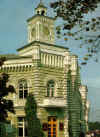


Moldova |
 |
 |
 |
Moldova Present-day Moldova
corresponds generally to the historic region of Bessarabia (Bessarabiya). In 1940
Bessarabia was annexed to the Union of Soviet Socialist Republics (USSR) and designated
the Moldavian Soviet Socialist Republic (SSR). Moldova (no longer known by the Russian
variant Moldavia) became an independent country in 1991. At the end of that year, it
signed the agreement establishing the Commonwealth of Independent States (CIS), an
organization composed of former Soviet republics. Moldova became a formal member of the
CIS in 1994. That year the country adopted its first post-Soviet constitution. In the
early 1990s secessionist movements among certain ethnic groups took hold in the
Trans-Dniester region in the extreme east and the Gagauz region in the south. The threat
to Moldova’s territorial integrity was largely resolved by the mid-1990s. Moldova ratified a new constitution in 1994 to replace the one of the Soviet period. The constitution confirmed Moldova’s status as an independent and democratic republic. It guarantees that all citizens age 18 and older may vote and provides for various other civil rights and freedoms. The president of Moldova is head of state. The president is directly elected to a four-year term and may serve no more than two consecutive terms. The president nominates the prime minister and, upon his or her recommendation, the cabinet. The prime minister and the cabinet must be approved by the Parlamentul (legislature). The president is empowered to dissolve the Parlamentul. The constitution provides that the president may be impeached for criminal or constitutional offenses. The Parlamentul, a unicameral (single-chamber) assembly, is the supreme legislative body of Moldova. Its 104 deputies are directly elected for four-year terms. The Parlamentul convenes for two ordinary sessions per year and may hold extraordinary sessions as well. In addition to enacting laws and performing other basic legislative functions, the Parlamentul is empowered to declare a state of emergency, martial law, and war. Moldova’s judicial system includes the Supreme Court of Justice (the country’s highest court), the Court of Appeal, and the Constitutional Court. Tribunals and courts of law adjudicate at the local level. There is also a Higher Magistrates’ Council, which is composed of 11 magistrates who serve for a period of five years. The council acts to ensure the appointment, transfer, and promotion of judges. The president of Moldova appoints judges to the Court of Appeal and the Supreme Court of Justice after the Higher Magistrates’ Council makes its recommendations. The judges are initially appointed for five-year terms; their terms may then be renewed for a period of ten years, after which they may continue to serve until they reach retirement age. The Constitutional Court is the supreme authority on constitutional matters; its decisions are not subject to appeal. It is composed of six judges—two chosen by the president, two by the Parlamentul, and two by the Higher Magistrates’ Council—who each serve for six years. For purposes of local government, Moldova is divided into 40 districts and 10 urban municipalities (including Chișinău). The municipalities are administered separately from the districts. All of the local jurisdictions are governed by locally elected councils. The prefects and mayors of districts and municipalities are appointed by Moldova’s president after being nominated by the local councils. The 1994 constitution included a provision to give the Gagauz and Trans-Dniester regions autonomous status, although the terms of self-governance were determined through later negotiations. Both regions enjoy broad powers of self-administration and have their own legislatures and chief executives. Moldova has many political parties. Those represented in the government include the Communist Party of Moldova, the Democratic Convention, and the Bloc for a Democratic and Prosperous Moldova. The Communists won the most seats in the legislative elections of 1998. During the Soviet period, all armed forces were part of a centralized security system. After Moldova gained independence from the USSR, the government of the republic began to create a national defense force. In 1996 Moldova’s armed forces numbered 11,900 personnel; most were in the army, with 1700 in the air force. In addition, Moldova has a paramilitary force of about 2500 (attached to the Ministry of the Interior) and a riot police force of 900. Military service is compulsory for 18-year-old males for up to 18 months. The 1994 constitution established Moldova as a permanently neutral state. Moldova is a member of the United Nations (UN), the Commonwealth of Independent States (CIS), the Organization on Security and Cooperation in Europe (OSCE), the Partnership for Peace program of the North Atlantic Treaty Organization (NATO), and the Council of Europe (CE). |